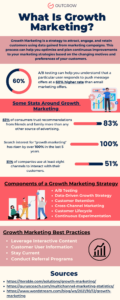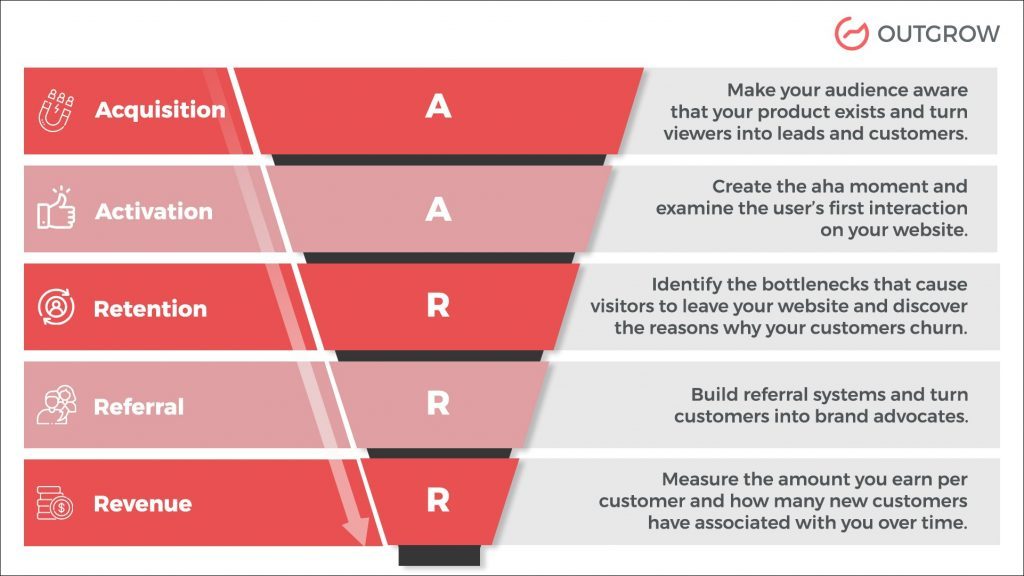What Is Growth Marketing? [Strategies and Examples]
Table of Contents
As we move into 2023, the rise of data enrichment has enabled more companies to focus on attracting, engaging, and retaining customers. The process involves constant experimentation, as well as a keen eye on your customers’ changing preferences and motives. So, if you’re looking to scale your company or are experiencing high growth and need to tweak your marketing techniques to improve your ROI, consider implementing some effective growth marketing ideas.
In this blog, we will take a closer look at what growth marketing is and some common opportunities for optimizing user experiences. So, if you’re interested in learning more about a good growth marketing strategy, keep reading.
What Is Growth Marketing?
Growth Marketing is a strategy to attract, engage, and retain customers using data gained from marketing campaigns. This process can help you optimize and plan continuous improvements for your marketing strategies based on the changing needs and preferences of your customers.
By creating and delivering highly tailored, personalized content that aligns with your customer’s needs, you can accelerate your organization’s growth. This is especially true across a number of channels, particularly those that your customers value most.
What Is the Role of the AARRR Framework in Growth Marketing?
The AARRR framework is one of the most popular frameworks for growth marketing created by growth hacking agencies. It is commonly referred to as the Pirate Funnel. This framework divides your growth strategies into five stages and assigns metrics to map each stage.
This framework helps you find the bottlenecks of a business and guides you in the right direction for growing your business. Consider, for example, that your customers do not return to your business after they make one purchase. What would you do then? This is where you should focus on retaining customers. There may be a possibility that your website lacks enough products or services, or your products or services aren’t valuable enough for your target audience. So, in order to retain customers, you need to address these questions first and then work around a solution to serve your target audience.
Some Statistics Around Growth Marketing
- A/B testing can help you first understand that a particular user responds to push message offers at a 60% higher rate than email marketing offers.
- 83% of consumers trust recommendations from friends and family more than any other source of advertising.
- Search interest for “growth marketing” has risen by over 100% in the last 5 years according to Google Trends.
- A customer is five times more likely to purchase again from you has motivated companies to invest in customer experiences.
- 51% of companies use at least eight channels to interact with their customers.
Components of a Growth Marketing Strategy
1. A/B Testing
A/B testing or multivariate testing is one of the core strategies of growth marketing. You can use this technique to test and compare the results of different content styles across a variety of formats, including email marketing, landing pages, social media posts, and more. In order to create an A/B test, you can write almost any piece of marketing content in two ways and compare both versions to track the results.
Consider creating two versions of your email newsletter. The first emphasizes a certain feature of your product, and the second emphasizes a different element. These two versions form the A and the B versions of A/B testing. After that, you can determine which converts better. By A/B testing different elements on your website or app, you can optimize your growth plan to maximize efficiency.
2. Data-Driven Growth Strategy
In order for your growth marketing campaign to be successful, you must develop a comprehensive plan. You can keep your growth marketing plan updated on a regular basis as you experiment with creative ideas and gather more data about your target audience. Additionally, in your growth plan, you should include relevant information such as your hypotheses, goals, audience, target market, marketing channel, and budget.
Among the types of data that can be tracked to make a successful growth marketing campaign are acquisition-related data (i.e., which platform people use to find your product), engagement rates (how many people use it or take certain actions in order to initiate a purchase), and conversion rates (how many people purchase your product and become your customers).
3. Customer Retention
As the name suggests, the aim of a successful growth marketing campaign is to retain your existing customers. For this, you need to prioritize engagement and retention from the very beginning. Instead of only concentrating on acquiring new customers, think about how you can also make them your loyal returning customers.
You can track your users’ engagement on your website and accordingly approach them with relevant interactive content based on their buying experience. Outgrow’s no-code interactive content tools can help you track and analyze your users’ engagement. For example, using our wide range of tools, you can share product recommendations, quizzes, calculators, giveaways, etc. with your customers based on their buying behavior. You can also conduct polls to find out more about their preferences and interests.
Pro Tip: We have created a blog just for you to help you create interactive content pieces in just a few minutes.
Our goal is to keep our users engaged from the moment they sign up until they buy a product or subscribe to a premium service. You can provide them with relevant content, offers, and 24/7 support. Your customers are more likely to stay with you if you keep them engaged and provide them with consistent value, which further strengthens customer loyalty and reduces churn. It’s about proactively managing the customer experience.
4. Cross-channel Marketing
The goal of cross-channel marketing is to build a strategy that reaches your customers across a variety of channels. Your cross-channel marketing campaigns should be tailored according to the platforms your individual users focus on for communication and buying purposes. You can include email marketing, SMS messaging, push notifications, in-app messages, direct mail, and other channels, based on your audience’s preferences and how you approach them.
For example, a particular user responds to push message offers at a 60% higher rate than what email marketing offers. Therefore, you can customize growth marketing campaigns to focus on push messages. It is also valuable to develop a holistic marketing plan that integrates multiple channels.
In this way, you will be able to engage your audience wherever they are, using contextual campaigns that help you understand their past behavior. This approach also complements Account-Based Marketing strategies when focusing on high-value accounts.
5. Customer Lifecycle
A customer lifecycle is a journey that your customer takes as they discover you, interact with you, buy from you and re-engage with your brand i.e. from the awareness stage to the purchase stage of the buying journey.
In order to optimize your growth marketing efforts at each stage, you must understand how your target customers progress through the customer journey. Your customers progress through this lifecycle at their own pace, but you should proactively accommodate their changing needs with need-specific campaigns. Also, by using a customer journey map, you can uncover growth opportunities and provide a more seamless
6. Continuous Experimentation
Through continuous experimentation, you can better understand your customers’ needs and learn more about them. As a result, you will be able to provide your target audience with relevant and engaging content.
To successfully experiment, you must be prepared to try various things and then use data interpretation to determine what works and what does not. In addition to this, you should always base your experiments on a deeper understanding of your data. This will enable you to see if there are any changes to be made to your growth marketing campaign.
By implementing all the strategies stated above, your growth marketing plan will drive your experiments, and with A/B testing, you can fine-tune those experiments for better results.
Growth Marketing Best Practices
1. Leverage Interactive Content
In growth marketing, personalization enhances the user experience, builds brand loyalty, and increases conversions. E-commerce brands can create a customized shopping experience to meet the needs of their customers, while B2B brands can personalize their websites by providing relevant content that addresses the pain points of their audience.
Outgrow‘s no-code tools are a one-stop solution that provides interactive content for both the B2B and B2C industries. With our interactive tools like quizzes, polls, product recommendations, giveaways, surveys, and assessments, you can gather a wide range of information about your audience. This will help you learn more about them so that you can target them based on their buying behavior.
When we talk about growth marketing, customer support becomes the key aspect. You can engage your customers using conversational chatbots and provide them with relevant content based on their buying behavior. With automated sales and customer support, you can optimize communication with prospects and customers.
Here’s a blog for you that will help you understand how you can nurture your leads and retain your customers using conversational chatbots.
2. Collect User Information
Creating growth marketing campaigns becomes easier when you have a comprehensive understanding of your audience and customers. It works best when you have “free” communication with your users and potential customers.
For example, you have your users’ email addresses, so you have the opportunity to engage with them and share personalized content based on their buying experience through email marketing campaigns. Or if they have signed up through a social channel for your website, then anything you publish is more likely to get in front of them for free.
This will motivate your users and give them an opportunity to visit your website and make a purchase. Eventually, it will increase the conversion rate and bring more traffic to your website.
3. Stay Current
Staying current is important!
Some techniques that worked a few years ago might not work now. The number of new channels with high ROI has also increased over the last few years. So, understanding trends in the industry and discovering the right tactics to maximize business growth are key elements of growth marketing.
But how will you do this? We have curated a blog just for you to make you understand the key marketing trends. Also, be sure to check out the Kissmetrics blog, which covers a variety of growth marketing tactics.
4. Conduct Referral Programs
A loyal customer base is the first step in getting the most out of the referral stage. When you have this loyal customer base ready, strategize a referral program to market your products. Existing customers can receive a percentage of the profits received from each referral they make. Your goal is to find the sweet spot where you maximize referral conversions for each dollar you spend.
In order to make your growth marketing campaign a huge success, you need to provide offers or discounts to your existing customers. This will also help you in attracting new users. In other words, your growth marketing strategy should focus on conducting referral programs that excite your current customers as well as your prospects.
For example, a two-sided referral program was introduced by Dropbox in which both the existing user and the new user received 500MB of free storage space as soon as the referred user signed up. As a result, the company was able to significantly reduce its ad spending to acquire new users and increased its conversion rates by 3900% in 15 months.
The Key Takeaway!
Growth marketing is more than just a buzzword for growing businesses!
We hope this blog helps you strategize your growth marketing campaigns effectively. If you have more ideas, you can share them in the comments section below.
Outgrow helps you plan your growth marketing campaigns using interactive content tools. Their no-code tools provide you with premade templates and layouts and help you create content pieces in just minutes.
So, what are you waiting for? Sign up for their FREE trial now!




